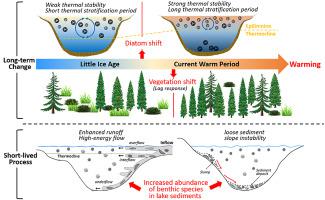当前位置:
X-MOL 学术
›
Quat. Sci. Rev.
›
论文详情
Our official English website, www.x-mol.net, welcomes your
feedback! (Note: you will need to create a separate account there.)
Lake diatom response to climate change and sedimentary events on the southeastern Tibetan Plateau during the last millennium
Quaternary Science Reviews ( IF 3.2 ) Pub Date : 2020-08-01 , DOI: 10.1016/j.quascirev.2020.106409 Mengna Liao , Ulrike Herzschuh , Yongbo Wang , Xingqi Liu , Jian Ni , Kai Li
Quaternary Science Reviews ( IF 3.2 ) Pub Date : 2020-08-01 , DOI: 10.1016/j.quascirev.2020.106409 Mengna Liao , Ulrike Herzschuh , Yongbo Wang , Xingqi Liu , Jian Ni , Kai Li

|
Abstract Climate change on the southeastern Tibetan Plateau (TP) is assumed to impact lake ecosystems. However, parallel changes in climate and non-climate factors and mediation of signals by catchment processes complicate the assessment of climate-change effects on lake ecosystems requiring long-term and high resolution multi-variable time-series. Here we present a diatom record from sediments in the lake Basomtso, southeastern TP, covering the period 1083–2012 CE with sub-decadal resolution which we relate to available proxies for potential climate and non-climate factors. The record is dominated by planktonic species and the compositional change is mainly characterized by alternations between big- and small-celled Pantocsekiella ocellata and between planktonic and benthic diatom species. The diatom assemblages show a decrease of P. ocellata (big form) since the end of 17th century and an increase of P. ocellata (small form) as well as an increase in diatom productivity, reflecting changes on a centennial timescale which mainly follow temperature increase. We recorded several changes in the ratio of planktonic to benthic species abundance (P: B) on a sub-decadal or decadal timescale. Noticeable decreases in P: B were a result of rapid sedimentary events caused by high energy flows. Cross-correlation analyses reveal synchronous responses of diatoms and asynchronous responses of terrestrial vegetation to regional temperature change, indicating a higher potential of lake diatoms to detect the timing and magnitude of climate shifts on the southeastern TP. The results imply that aquatic ecosystems in Basomtso, as well as in other mountain lakes on the southeastern TP, are probably subject to a larger risk of regime shift than terrestrial ecosystems under future climate scenarios.
中文翻译:

近千年青藏高原东南部湖泊硅藻对气候变化和沉积事件的响应
摘要 青藏高原东南部(TP)的气候变化被认为会影响湖泊生态系统。然而,气候和非气候因素的平行变化以及流域过程对信号的调节使气候变化对湖泊生态系统影响的评估变得复杂,需要长期和高分辨率的多变量时间序列。在这里,我们展示了青藏高原东南部巴松措湖沉积物中的硅藻记录,涵盖了公元 1083 年至 2012 年期间的年代际分辨率,我们将其与潜在气候和非气候因素的可用代理相关联。该记录以浮游物种为主,组成变化的主要特征是大细胞和小细胞 Pantocsekiella ocellata 之间以及浮游和底栖硅藻物种之间的交替。硅藻组合显示 P 减少。ocellata(大型)自 17 世纪末和 P. ocellata(小型)的增加以及硅藻生产力的增加,反映了百年时间尺度上的变化,主要是随着温度的升高。我们记录了亚十年或十年时间尺度上浮游生物与底栖物种丰度(P:B)比率的一些变化。P: B 的显着下降是由高能量流引起的快速沉积事件的结果。互相关分析揭示了硅藻对区域温度变化的同步响应和陆地植被的异步响应,表明湖泊硅藻在检测高原东南部气候变化的时间和幅度方面具有更高的潜力。结果表明,巴松措以及青藏高原东南部其他高山湖泊的水生生态系统,
更新日期:2020-08-01
中文翻译:

近千年青藏高原东南部湖泊硅藻对气候变化和沉积事件的响应
摘要 青藏高原东南部(TP)的气候变化被认为会影响湖泊生态系统。然而,气候和非气候因素的平行变化以及流域过程对信号的调节使气候变化对湖泊生态系统影响的评估变得复杂,需要长期和高分辨率的多变量时间序列。在这里,我们展示了青藏高原东南部巴松措湖沉积物中的硅藻记录,涵盖了公元 1083 年至 2012 年期间的年代际分辨率,我们将其与潜在气候和非气候因素的可用代理相关联。该记录以浮游物种为主,组成变化的主要特征是大细胞和小细胞 Pantocsekiella ocellata 之间以及浮游和底栖硅藻物种之间的交替。硅藻组合显示 P 减少。ocellata(大型)自 17 世纪末和 P. ocellata(小型)的增加以及硅藻生产力的增加,反映了百年时间尺度上的变化,主要是随着温度的升高。我们记录了亚十年或十年时间尺度上浮游生物与底栖物种丰度(P:B)比率的一些变化。P: B 的显着下降是由高能量流引起的快速沉积事件的结果。互相关分析揭示了硅藻对区域温度变化的同步响应和陆地植被的异步响应,表明湖泊硅藻在检测高原东南部气候变化的时间和幅度方面具有更高的潜力。结果表明,巴松措以及青藏高原东南部其他高山湖泊的水生生态系统,







































 京公网安备 11010802027423号
京公网安备 11010802027423号